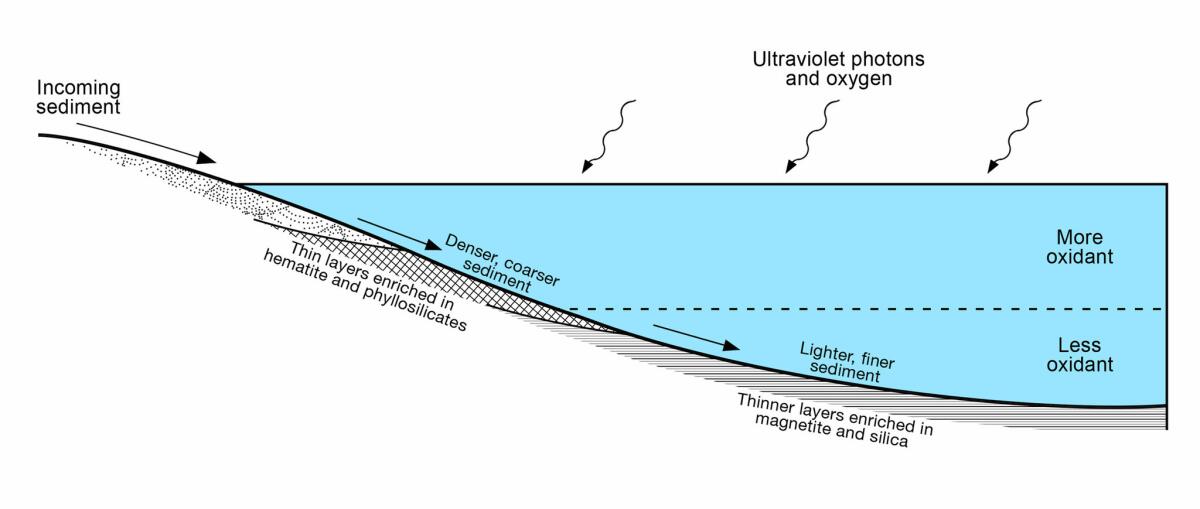An ancient lake on Mars could have supported a variety of microbial life
Scientists with
The findings, published last week in the journal Science, document a long-lasting Martian environment that had the potential to host a diverse array of living things.
“It helps to broaden our understanding of what it meant to be a habitable environment on Mars, 3 ½ billion years ago,” said lead author Joel Hurowitz, a geochemist at Stony Brook University.
Since landing in Gale Crater in 2012, Curiosity has drilled, X-rayed and laser-blasted a variety of rocks in the quest to understand whether the Red Planet — a world that began much like our own — could ever have been hospitable to life. Using its state-of-the-art instruments, Curiosity’s mission was to drive to Mount Sharp, the 3-mile-high mound in the middle of the crater. There, it would climb its slopes, reading each sedimentary layer of rock like a chapter in the geologic history of Mars.
On its journey, Curiosity discovered evidence of past water and the right chemical ingredients for life; recent studies have found that Gale Crater was once filled with a series of lakes that may have risen and fallen over time.
“The mission is really opening our eyes to just how Earth-like a place Mars has been at times and places in its ancient history,” Hurowitz said.

But what was that ancient body of water like? In this new study, scientists have now put together the evidence from several spots along the journey to and up Mount Sharp, including six drilled rock samples pulled from very different ancient environments. The results revealed a wealth of the ingredients needed for life as we know it, including organic carbon compounds, nitrogen, and phosphate minerals, as well as iron and sulfur minerals in different redox states.
“Our analysis of those rocks indicates that gradients in lakewater oxidation state were present in the primary lacustrine environment,” the study authors wrote. “Taken together, these results provide compelling evidence that the physical, chemical, and energetic conditions necessary to establish a habitable environment were present on Mars between 3.8 and 3.1 [billion years ago].”
The scientists also noticed a strange pattern in a stretch of layered rock. There were regions where lots of coarse sediment had been rapidly dumped — marking the shallows where water flowing into the lake from a stream or river would have dropped much of its heavy material. There were also areas where much finer-grained sediment had been layered on more gradually — closer to the middle of the lake, and farther away from the river mouth.
Here was the odd bit: Chemically speaking, the minerals in the shallower parts of the lake appear to have been exposed to more oxygen, while the minerals in the deeper areas had not.
It seems that the waters of Gale’s lake had, for at least a portion of its history, differentiated into an oxygen-rich layer near the surface, and an oxygen-poor layer in its depths. That’s a lot like lakes on Earth, which also differentiate in the same way.
“It’s that relationship between the mineralogy and the thickness of the sediment layers that allows us to connect the dots,” said study co-author Ashwin Vasavada, the mission’s project scientist at Jet Propulsion Laboratory.
This complex lake could have lasted anywhere from hundreds of thousands of years to 10 million years, Hurowitz said. Like the lakes on Earth, the one in Gale Crater could have hosted a variety of microorganisms, including some that preferred the oxygenated waters near the surface, others who preferred the anoxic waters deeper down, and those who liked to hang out at the interface between the two.
Over this period, the scientists also found that Mars seemed to progress from a colder, drier environment to a warmer, wetter one. On top of that, its layers of sedimentary record were modified by what appears to be briny liquid. Studying these rocks could help scientists understand the ultimate drying of Mars as its water escaped to space, leaving the salts behind.
For now, there’s no way to know whether life ever did emerge on the Red Planet; Curiosity is only designed to determine whether environments are habitable, not inhabited. That question will have to wait for future missions, including the Mars 2020 rover, which will collect and cache promising rock samples for later spacecraft to come retrieve.
Follow @aminawrite on Twitter for more science news and "like" Los Angeles Times Science & Health on Facebook.
MORE IN SCIENCE
LIGO detects third black-hole collision — and it's not quite like the others
How a 5-sentence letter helped fuel the opioid addiction crisis
NASA spacecraft bound for the sun is renamed for the astrophysicist who discovered the solar wind
UPDATES:
June 6, 11:15 a.m.: This story has been updated with additional information from Joel Hurowitz.
This story was originally published June 5 at 3:40 p.m.




